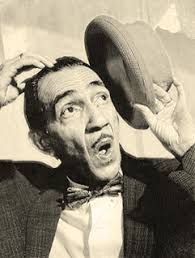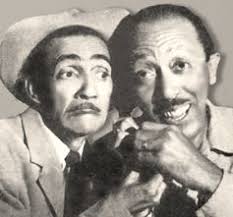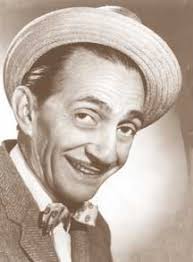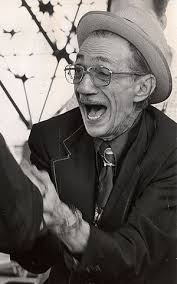 LEOPOLDO “POTOTO” FERNANDEZ, COMEDIANTE, ACTOR DEL CINE Y LA TELEVISION.
LEOPOLDO “POTOTO” FERNANDEZ, COMEDIANTE, ACTOR DEL CINE Y LA TELEVISION.
Leopoldo Augusto Fernández Salgado nació en Jagüey Grande, Cuba, el 26 de diciembre de 1904. Cuando era todavía un niño debió abandonar sus estudios y ponerse a trabajar como repartidor de pan, para ayudar a la economía familiar.
El afán de superación llevó al joven Leopoldo a hacerse telegrafista, oficio que luego cambió por el de tabaquero en la pequeña ciudad de Güines, al sur de La Habana. Su gracia natural y su espíritu lúdico lo acercaron al mundo de los espectáculos.
En 1926, Leopoldo regresa a Jagüey Grande y forma una compañía teatral junto con unos amigos. En ese mismo año es contratado para una gira nacional con Blanquita Gómez. Al terminar la gira vuelve a su ciudad natal para reincorporarse a su compañía, y viaja a La Habana donde conoce a Cándita Quintana, Federico Piñero, Alberto Garrido y a Mimí Cal, quien sería su esposa durante dieciséis años. Sus actuaciones lo llevaron a países como Puerto Rico, Venezuela, Colombia, Perú y la República Dominicana.
https://youtu.be/1pF9Yz6k56k
Tras recorrer varios países de América con mucho éxito, en 1939 regresa a la Isla y conoce a Cástor Vispo (escritor) y a Mario Barral (productor). Trabajó en Venezuela por varios años, y en 1941 presentó en el Teatro Hispano de Nueva York a su Gran Compañía Cubana de Leopoldo Fernández, con éxito de público y crítica.
CARRERA ARTISTICA.
En 1931 (en plena época de oro de la zarzuela cubana), hizo su debut teatral en el Teatro Martí, en la comedia lírica Frivolina, presentada por la Compañía Cubana de Zarzuelas de la empresa Suárez-Rodríguez. Fernández sustituyó temporalmente al actor Alberto Garrido, titular de los papeles de «negrito». Después formó parte, de diciembre de 1931 a enero de 1932, de la Compañía de Revistas y Zarzuelas de Robreño-Grenet, en el teatro Payret. A su labor actoral añadió las de director artístico y autor dramático.
Es en 1942 (ó 1941) en que la emisora radial RHC “Cadena Azul” inaugura “La Tremenda Corte”. Su facilidad para causar la risa en los auditorios que acudían a sus espectáculos, lo convirtió en figura insuperable dentro del teatro popular cubano. Su secreto estaba en el contraste entre su gracia verbal y su carácter ríspido enmarcados en el rostro poco expresivo y la figura magra. Su fuerza estaba en la palabra, en el chiste repentino o la frase chusca dicha en el momento justo, y que consiste en decir las cosas más hilarantes y disparatadas con sólo mover las manos y sin variar la expresión. Los deliciosos libretos de Castor Vispo satirizaban el desempeño de los Juzgados Correccionales y tenían como principal resorte malabarismos de lenguaje, a partir de anfibologías y retruécanos, a los que se sumaban la capacidad de improvisación de Fernández y su excelente química con Aníbal de Mar. El programa alcanzó elevados índices de audiencia y llegó a ser muy popular.
Leopoldo Fernández también popularizó durante finales la década de los cincuenta y principios de la siguiente década, otros personajes humorísticos con gran aceptación como el Vigilante Chegoya del programa radial “El Precinto Competidora” y “Domitilo” en la producción televisiva “Los Ricachos”. Pero tras Trespatines, el personaje de Pototo, del dueto Pototo y Filomeno, fue el que nuevamente lo condujo a cimas de popularidad. El programa pasó de la radio a la televisión, y al mismo tiempo los solicitados personajes aparecían en los shows de los centros nocturnos de La Habana y en la cinematografía de la época. Algunos de los filmes protagonizados por Leopoldo Fernández fueron El vigilante Chegoya (1948); Música, mujeres y piratas (1950); Príncipe de contrabando (1950), Hotel de muchachas (1951), ¡Olé…Cuba! (1957) y Surcos de libertad (1959). En muchos de estos filmes participó junto a su amigo de siempre Aníbal de Mar.
Aunque Leopoldo Fernández era hombre atildado y de pulcritud en el vestir, adornaba sus creaciones con un sombrerito de paja, un delgado corbatín y sacos con rayas verticales gruesas que le daban un toque de aristocracia, estilo del actor y director francés Jacques Tati, insertado en el trópico caribeño. Esta fue la misma indumentaria que llevó inicialmente a la radio, y que gracias al ingenio y la agudeza del comediógrafo Cástor Vispo, con su inolvidable creación “La Tremenda Corte”, harían internacionalmente conocido a Fernández, entonces bautizado dentro del programa como “Trespatines”, un personaje cínico y deslenguado –pero gracioso–, sobre el cual giraba la trama de todos los episodios creados por Vispo.
Entre aquellas personas que trabajaron junto a Leopoldo en La Tremenda Corte se recuerda a Aníbal del Mar (El Tremendo Juez), Adolfo Otero, Julito Díaz, Jesús Alvariño, Julita Muñoz y la inefable “Nananina”, recreada por Manuela “Mimí” Cal, mujer de Trespatines por varios años y de quien después se divorció, aunque siguieron trabajando juntos en el programa, compartiendo las inevitables situaciones de rompe y rasga, de vaya y venga; naturales entre quienes han sido fuego y ahora sólo guardan rescoldo.
Su discografía, conformada por diálogos cómicos y números musicales con Aníbal de Mar, ocupó los primeros lugares en los ‘hits parades’ de la época. Uno de sus LP obtuvo un Disco de Oro en 1957.
Continuó compartiendo el trabajo en los medios con la labor teatral. Con sus compañías Trespatines Follies y Compañía de Leopoldo Fernández, presentó temporadas en los teatros Campoamor, Actualidades, Martí, y otros, con enorme éxito de público.
En 1959 llegó a México, y después a Puerto Rico, participando en teatro, televisión y cine. Entre noviembre de 1960 y mayo de 1962 realizó funciones diarias con la Compañía de Revistas de Leopoldo Fernández en el Teatro Estrada Palma (llamado desde 1961 Teatro Federico García Lorca). Para ese entonces Leopoldo Fernández era un hombre famoso.
ANECDOTAS DE SU VIDA ARTISTICA.
Una anécdota atribuida a Trespatines habla del día en que, durante una temporada en el antiguo Teatro Nacional de La Habana en 1961, Pototo y otro actor revisaban un archivo de fotos de los presidentes de Cuba para instalarlos en la pared. El otro actor mostró una foto de Batista y Leopoldo le dijo: –A éste lo botas… El actor siguió sacando diferentes figuras de políticos con la invariable respuesta del comediante: –A éste también lo botas… Finalmente, el ayudante sacó una foto de Fidel Castro. Leopoldo la miró, la mostró al público y dirigiéndose a la pared, dijo con su habitual socarronería: –Déjame que a éste lo quiero colgar yo…
En 1969, Panamericana TV de Perú compró los derechos de La Tremenda Corte. Además contrató por una corta temporada a Leopoldo Fernández para otra variante del programa, llamada “El Guardia Trespatines”, en la que encarnaba a un policía de sabor tropical y donde su jefe era Antonio Salim (Bonifacio Palomino) junto a otros cómicos del medio como los peruanos Jorge Montoro y la guapísima Anita Saravia. Una última adaptación del programa, esta vez llamada “Trespatines en su Salsa” fue también una producción realizada en Perú, allá por 1970, en donde participa junto con su hijo Leo Fernández Jr., su otro hijo Pucho Fernandez y un nuevo elenco.
Otras películas en las que participó Leopoldo fueron “Las vírgenes de la nueva ola” en 1969 y “El profeta Mimí” en 1973, ambas películas fueron producciones mexicanas.
Leopoldo Fernández tuvo durante su carrera varios nombres: Chegoya, Agente 3K3, y Pototo en que hizo pareja con Aníbal del Mar, el inolvidable Filomeno y por supuesto Trespatines. También esta pareja de Aníbal y Leopoldo hizo un dúo conocido como “Nicanor y Cuatro Kilos”. En 1969 llegó a realizar una película en colores, llamada “Trespatines en Acción”, la cual fue dirigida por Manny San Fernando. Fue filmada en Puerto Rico y Miami. Esta fue una serie donde Trespatines trabajaba en una jefatura de Policía, pero la producción duró poco tiempo. en 1970 años también realizó varias cortas comedias para televisión, una de ellas era una llamada “Yo Detesto a las Mujeres”, en donde Leopoldo era el protagonista junto a Vilma Carbia. En 1971 presentó en varios teatros hispanoamericanos de New York, su comedia titulada “Lo Tengo Pisao”.
VIDA PERSONAL.
A lo largo de su vida, Leopoldo estuvo casado muchas veces, estos son algunos de los matrimonios que se le conocen: 1) Lenia, se desconoce su nombre completo. Ella quizás la madre de Leopoldo “Pucho” Fernández II y Lenia. 2) Mimí Cal, con quien se casó por espacio de 10 a 16 años. No hubo hijos en este matrimonio. 3) Eneida González, también conocida como Eny González, fue esposa de Leopoldo durante la época en que él salió de Cuba. 4) Rosaura Andreu fue una actriz cubana conocida en Puerto Rico por su personaje “Titi Chagua”, el sitio web de La Fundación Román Rivero hace mención del joven actor Miguelito Fernández, hijo de Rosaura Andreu y Leopoldo Fernández. Esta actriz fallece en noviembre del 2010, tal y como se consigna en una publicación del periódico puertorriqueño El Nuevo Día y en dicho artículo una vez más se menciona el matrimonio y al hijo que ambos tuvieron. 4) Vilma Carbia. Ella fue su última esposa, y no hubo hijos en este matrimonio.
Lo que si es claro es que tuvo varias otras compañeras sentimentales, ya que de todos los hijos que tuvo, no todos ellos son de los matrimonios anteriormente citados. Leopoldo tuvo en total ocho hijos, todos ellos reconocidos pues llevan su apellido, aunque es difícil asegurar si todos ellos fueron hijos de sangre o si alguno fue por adopción. El primero de ellos fue Leopoldo “Pucho”,fue un comediante muy querido en Puerto Rico con un personaje conocido como “20/20”, Lenia, Leopoldo Junior (Polito), Leonor, Leobaldo, Leonel y Leonora. De los últimos 5 no se tienen datos acerca de quien fue su madre. El que falta por mencionar es Miguel (Miguelito), cuya madre fue Rosaura Andreu. De Leopoldo Fernández Jr. (Polito), se desconoce la identidad de la madre.
Alrededor de 1984 Leopoldo Fernandez se retiró de la actuación. El genial cómico murió en Miami el 11 de noviembre de 1985 a los 82 años, allí residía con su esposa, la actriz puertorriqueña Vilma Carbia.
 LEOPOLDO “POTOTO” FERNANDEZ, COMEDIAN, ACTOR OF CINEMA AND TELEVISION.
LEOPOLDO “POTOTO” FERNANDEZ, COMEDIAN, ACTOR OF CINEMA AND TELEVISION.
Leopoldo Augusto Fernández Salgado was born in Jagüey Grande, Cuba, on December 26, 1904. When he was still a child, he had to abandon his studies and start working as a bread delivery boy, to help the family economy.
The eagerness to overcome led the young Leopoldo to become a telegrapher, an office that later changed to that of cigar maker in the small town of Güines, south of Havana. His natural grace and playful spirit brought him closer to the world of shows.
In 1926, Leopoldo returns to Jagüey Grande and forms a theater company with some friends. In that same year, he was hired for a national tour with Blanquita Gómez. At the end of the tour returns to his hometown to rejoin his company, and travels to Havana where he meets Cándita Quintana, Federico Piñero, Alberto Garrido and Mimí Cal, who would be his wife for sixteen years. His performances took him to countries such as Puerto Rico, Venezuela, Colombia, Peru, and the Dominican Republic.
After touring several countries in America with great success, in 1939 he returned to the island and met Cástor Vispo (writer) and Mario Barral (producer). He worked in Venezuela for several years, and in 1941 he presented at the Hispano Theater of New York his Great Cuban Company of Leopoldo Fernández, with success of public and critics.
ARTISTIC CAREER.
It was in 1942 (or 1941) that the radio station RHC “Cadena Azul” inaugurated “La Tremenda Corte”. His facility to cause laughter in the audiences that attended his shows made him an insurmountable figure in Cuban popular theater. His secret was in the contrast between his verbal grace and his crafty character framed in the little expressive face and the lean figure. His strength was in the word, in the sudden joke or the phrase jokes told at the right time, and that is to say the most hilarious and crazy things just by moving your hands and without changing the expression. The delicious scripts of Castor Vispo satirized the performance of the Correctional Courts and had as mainspring juggling of language, from amphibologies and puns, to which were added the ability of improvisation of Fernandez and his excellent chemistry with Aníbal de Mar. the program reached high ratings and became very popular.
Leopoldo Fernández also popularized during the late fifties and early next decade, other humorous characters with great acceptance as the Vigilante Chegoya of the radio program “El Precinto Competidora” and “Domitilo” in the television production “Los Ricachos”. But after Trespatines, the character of Pototo, the Dueto Pototo and Filomeno, was the one that once again led him to popularity heights. The program went from radio to television, and at the same time, the requested characters appeared in the nightclub shows in Havana and in the cinematography of the time. Some of the films starring Leopoldo Fernández were El vigilante Chegoya (1948); Music, women, and pirates (1950); Prince of contraband (1950), Hotel de chicas (1951), Olé … Cuba! (1957) and Furrows of Freedom (1959). In many of these films, he participated with his longtime friend Aníbal de Mar.
Among those who worked with Leopoldo in La Tremenda Corte are Aníbal del Mar (The Tremendous Judge), Adolfo Otero, Julito Díaz, Jesús Alvariño, Julita Muñoz and the ineffable “Nananina”, recreated by Manuela “Mimí” Cal, Trespatines woman for several years and who later divorced, although they continued to work together in the program, sharing the inevitable situations of break and tear, go and come; natural among those who have been fire and now only keep embers.
His discography, consisting of comic dialogues and musical numbers with Aníbal de Mar, occupied the first places in the ‘hits parades’ of the time. One of his LPs obtained a Gold Record in 1957.
In 1959 he arrived in Mexico, and later in Puerto Rico, participating in theater, television, and film. Between November 1960 and May 1962, he performed daily functions with the Leopoldo Fernández Magazine Company at the Estrada Palma Theater (called since 1961 Teatro Federico García Lorca). By then Leopoldo Fernández was a famous man.
ANECDOTES OF YOUR ARTISTIC LIFE.
An anecdote attributed to Trespatines speaks of the day when, during a season in the old National Theater of Havana in 1961, Pototo and another actor reviewed a file of photos of the presidents of Cuba to install them on the wall. The other actor showed a picture of Batista and Leopoldo told him: -To this one boots … The actor continued to draw different figures of politicians with the invariable response of the comedian: -A this one also boots … Finally, the assistant pulled a photo of Fidel Castro. Leopoldo looked at her, showed her to the audience and went to the wall, he said with his usual slyness: -Let me let him hang this one …
Other films in which Leopoldo participated were “The virgins of the new wave” in 1969 and “The prophet Mimi” in 1973, both films were Mexican productions. In 1971 he presented his comedy “Lo Tengo Pisao” in several Spanish-American theaters in New York.
PERSONAL LIFE.
Throughout his life, Leopoldo was married many times, these are some of the marriages that are known: 1) Lenia, his full name is unknown. She may be the mother of Leopoldo “Pucho” Fernández II and Lenia. 2) Mimi Cal, with whom she married for 10 to 16 years. There were no children in this marriage. 3) Eneida González, also known as Eny González, was Leopoldo’s wife during the time he left Cuba. 4) Rosaura Andreu was a Cuban actress known in Puerto Rico for her character “Titi Chagua”, the website of The Roman Rivero Foundation mentions the young actor Miguelito Fernández, son of Rosaura Andreu and Leopoldo Fernández. This actress dies in November 2010, as stated in a publication of the Puerto Rican newspaper El Nuevo Día and in that article once again mentions the marriage and the son they both had. 4) Vilma Carbia. She was his last wife, and there were no children in this marriage.
What is clear is that she had several other sentimental partners, since of all the children she had, not all of them are from the aforementioned marriages. Leopoldo had a total of eight children, all of them recognized as they carry his surname, although it is difficult to say if they were all blood sons or if any were by adoption. The first of them was Leopoldo “Pucho”, he was a well-liked comedian in Puerto Rico with a character known as “20/20”, Lenia, Leopoldo Junior (Polito), Leonor, Leobaldo, Leonel and Leonora. Of the last 5, there is no data about who was his mother. The one that remains to be mentioned is Miguel (Miguelito), whose mother was Rosaura Andreu. From Leopoldo Fernández Jr. (Polito), the identity of the mother is unknown.
Around 1984 Leopoldo Fernandez withdrew from acting. The great comedian died in Miami on November 11, 1985, at age 82, where he lived with his wife, the Puerto Rican actress Vilma Carbia.
Agencies/ Wiki/ La Tremenda Corte/ Internet Photo/ YouTube/ Arnoldo Varona/ www.TheCubanHistory.com
THE CUBAN HISTORY, HOLLYWOOD.



 < LEOPOLDO "POTOTO" Fernández, Comedian, Film and Television Actor. VIDEOS.
< LEOPOLDO "POTOTO" Fernández, Comedian, Film and Television Actor. VIDEOS.








